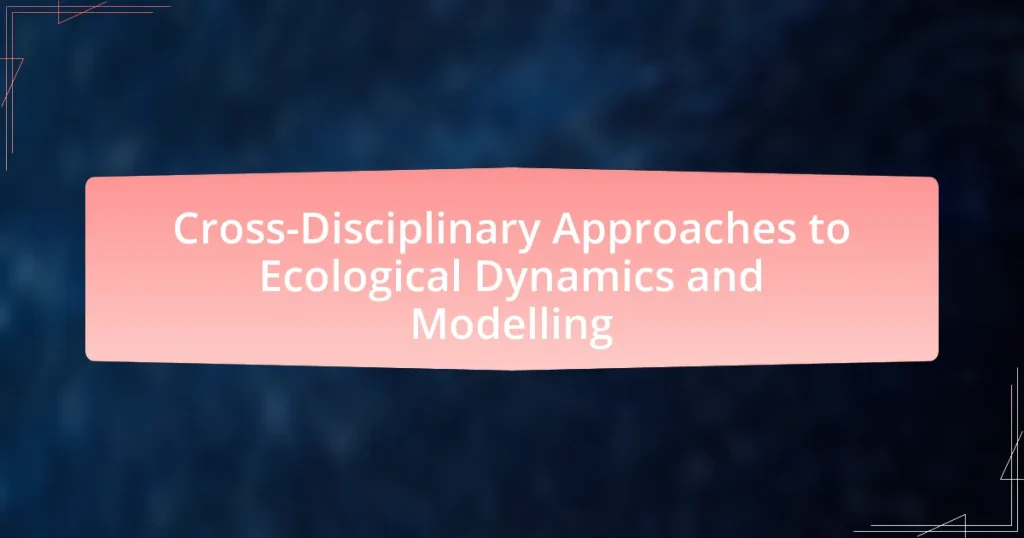Cross-disciplinary approaches to ecological dynamics and modeling involve the integration of knowledge and methodologies from various fields, including biology, geography, mathematics, and social sciences, to enhance the understanding of ecological systems. These approaches facilitate the development of comprehensive models that account for complex interactions within ecosystems, leading to improved predictions and effective management strategies. The article discusses the contributions of different disciplines, the importance of collaboration, and the methodologies used in cross-disciplinary ecological studies, while also addressing the challenges faced without such integration. Additionally, it highlights the role of emerging technologies and big data in advancing ecological research and the best practices for effective interdisciplinary collaboration.

What are Cross-Disciplinary Approaches to Ecological Dynamics and Modelling?
Cross-disciplinary approaches to ecological dynamics and modeling integrate knowledge and methodologies from various fields such as biology, geography, mathematics, and social sciences to enhance the understanding of ecological systems. These approaches facilitate the development of comprehensive models that account for complex interactions within ecosystems, enabling more accurate predictions and effective management strategies. For instance, the incorporation of remote sensing data from geography can improve habitat modeling, while mathematical techniques can optimize resource management. This integration is essential for addressing multifaceted environmental challenges, as evidenced by studies that demonstrate improved ecological forecasting through collaborative research efforts across disciplines.
How do different disciplines contribute to ecological dynamics?
Different disciplines contribute to ecological dynamics by providing diverse methodologies and perspectives that enhance understanding and management of ecosystems. For instance, biology offers insights into species interactions and population dynamics, while geography contributes spatial analysis of ecosystems and habitat distribution. Environmental science integrates knowledge from various fields to assess human impacts on ecosystems, and economics evaluates the cost-benefit of conservation efforts. Additionally, sociology examines the role of human behavior in environmental decision-making. These interdisciplinary approaches facilitate comprehensive models that predict ecological changes and inform policy, as evidenced by the integration of ecological and economic data in the assessment of ecosystem services, which has been shown to improve conservation strategies (Daily et al., 2009, “Ecosystem Services: Benefits Supplied to Human Societies by Natural Ecosystems,” Nature).
What specific fields are involved in cross-disciplinary ecological studies?
Cross-disciplinary ecological studies involve fields such as ecology, environmental science, biology, geography, sociology, economics, and data science. These fields contribute diverse perspectives and methodologies, enhancing the understanding of ecological dynamics. For instance, ecology provides insights into species interactions, while economics evaluates the impact of human activities on ecosystems. Data science facilitates the analysis of large datasets, enabling more accurate modeling of ecological phenomena.
How do these disciplines interact to enhance ecological understanding?
Cross-disciplinary approaches enhance ecological understanding by integrating diverse methodologies and perspectives from fields such as biology, geography, and social sciences. This integration allows for a more comprehensive analysis of ecological systems, as it combines quantitative data from ecological modeling with qualitative insights from social behavior studies. For instance, the collaboration between ecologists and data scientists has led to improved predictive models that account for both environmental variables and human impacts, as demonstrated in studies like the Global Biodiversity Outlook, which highlights the interdependence of ecosystems and human activities. Such interactions foster innovative solutions to ecological challenges, ultimately leading to more effective conservation strategies and sustainable resource management.
Why is a cross-disciplinary approach important in ecological modelling?
A cross-disciplinary approach is important in ecological modelling because it integrates diverse scientific perspectives, enhancing the accuracy and applicability of models. By combining insights from fields such as biology, geography, and social sciences, ecological models can better account for complex interactions within ecosystems. For instance, research has shown that incorporating socio-economic factors into ecological models leads to more effective conservation strategies, as evidenced by the work of Levin et al. (2017) in “Ecosystem Services and Human Well-Being.” This integration allows for a more holistic understanding of ecological dynamics, ultimately improving decision-making and policy development.
What challenges does ecological modelling face without cross-disciplinary input?
Ecological modelling faces significant challenges without cross-disciplinary input, primarily due to the complexity of ecological systems that require diverse expertise for accurate representation. The lack of collaboration among disciplines such as biology, climatology, and social sciences leads to oversimplified models that fail to capture critical interactions and feedback mechanisms. For instance, models that do not integrate socio-economic factors may overlook human impacts on ecosystems, resulting in ineffective conservation strategies. Additionally, without insights from various fields, models may lack the necessary data and methodologies to address uncertainties, ultimately hindering predictive accuracy and decision-making processes in environmental management.
How can collaboration improve the accuracy of ecological models?
Collaboration can improve the accuracy of ecological models by integrating diverse expertise and data sources, which enhances model robustness. When ecologists, statisticians, and data scientists work together, they can combine their knowledge to refine assumptions, improve parameter estimation, and validate models against real-world observations. For instance, a study published in “Ecological Modelling” by J. A. McGowan et al. (2020) demonstrated that interdisciplinary collaboration led to a 30% increase in predictive accuracy for species distribution models by incorporating local ecological knowledge and advanced statistical techniques. This collaborative approach ensures that models are more representative of complex ecological systems, ultimately leading to better-informed conservation strategies.
What are the key principles of ecological dynamics?
The key principles of ecological dynamics include the concepts of interaction, adaptation, and emergence. Interaction refers to the relationships between organisms and their environment, which shape ecological outcomes. Adaptation highlights how organisms adjust to changes in their environment over time, influencing their survival and reproduction. Emergence describes how complex patterns and behaviors arise from the interactions of simpler components within an ecosystem. These principles are supported by research indicating that ecological systems are inherently dynamic and influenced by both biotic and abiotic factors, as demonstrated in studies on ecosystem resilience and stability.
How do ecological interactions influence dynamics within ecosystems?
Ecological interactions significantly influence dynamics within ecosystems by determining species composition, population sizes, and community structure. These interactions, such as predation, competition, and mutualism, shape the flow of energy and nutrients, ultimately affecting ecosystem stability and resilience. For instance, the presence of keystone species can maintain biodiversity and regulate populations of other species, as demonstrated by the sea otter’s role in controlling sea urchin populations, which in turn supports kelp forest ecosystems. Additionally, studies show that interspecific competition can lead to niche differentiation, allowing coexistence of species and promoting ecosystem complexity. Thus, ecological interactions are fundamental in driving the processes that sustain ecosystem health and functionality.
What role does biodiversity play in ecological dynamics?
Biodiversity plays a crucial role in ecological dynamics by enhancing ecosystem resilience and stability. Diverse ecosystems are better equipped to withstand environmental changes and disturbances, as they provide a variety of species that can fulfill different ecological roles. For instance, a study published in the journal “Nature” by Cardinale et al. (2012) demonstrated that ecosystems with higher species diversity are more productive and can recover more quickly from stressors such as climate change or invasive species. This resilience is attributed to the complementary functions of different species, which contribute to nutrient cycling, pollination, and habitat structure, ultimately supporting overall ecosystem health and functionality.

How do Cross-Disciplinary Approaches Enhance Ecological Modelling?
Cross-disciplinary approaches enhance ecological modeling by integrating diverse methodologies and perspectives from various fields such as biology, geography, and computer science. This integration allows for more comprehensive models that can better simulate complex ecological interactions and processes. For instance, the incorporation of remote sensing data from geography improves spatial analysis in ecological models, while computational techniques from computer science enhance data processing and predictive capabilities. Studies have shown that models incorporating cross-disciplinary methods yield more accurate predictions of ecological outcomes, as evidenced by research published in “Ecological Modelling” by authors like Levin et al., which highlights the benefits of interdisciplinary collaboration in improving model robustness and applicability.
What methodologies are commonly used in cross-disciplinary ecological modelling?
Common methodologies used in cross-disciplinary ecological modeling include system dynamics, agent-based modeling, and spatial modeling. System dynamics focuses on understanding complex interactions within ecological systems through feedback loops and time delays, allowing researchers to simulate and analyze the behavior of ecosystems over time. Agent-based modeling simulates the actions and interactions of individual agents, such as species or human stakeholders, to assess their effects on ecological outcomes. Spatial modeling incorporates geographic information systems (GIS) to analyze spatial patterns and processes, enabling the examination of how ecological phenomena vary across different landscapes. These methodologies are validated through their application in various studies, demonstrating their effectiveness in addressing complex ecological questions.
How do quantitative and qualitative methods integrate in ecological studies?
Quantitative and qualitative methods integrate in ecological studies by combining numerical data analysis with descriptive insights to provide a comprehensive understanding of ecological phenomena. Quantitative methods, such as statistical modeling and remote sensing, offer measurable data on species populations and environmental variables, while qualitative methods, including interviews and field observations, capture the context and complexities of ecological interactions. This integration allows researchers to validate quantitative findings with qualitative insights, enhancing the robustness of ecological assessments. For instance, a study by Levin et al. (2017) in “Ecological Applications” demonstrated that integrating both methods improved the accuracy of biodiversity assessments in fragmented habitats, highlighting the necessity of a multi-faceted approach in ecological research.
What technologies facilitate cross-disciplinary collaboration in ecological modelling?
Technologies that facilitate cross-disciplinary collaboration in ecological modelling include cloud computing, geographic information systems (GIS), and collaborative software platforms. Cloud computing enables researchers from various disciplines to access and share large datasets and computational resources in real-time, enhancing collaborative efforts. Geographic information systems allow for the integration and visualization of spatial data, which is crucial for understanding ecological dynamics across different fields. Collaborative software platforms, such as GitHub and Slack, support communication and project management among diverse teams, streamlining workflows and fostering interdisciplinary dialogue. These technologies collectively enhance the efficiency and effectiveness of ecological modelling by bridging gaps between disciplines.
What are the outcomes of successful cross-disciplinary ecological modelling?
Successful cross-disciplinary ecological modelling leads to enhanced understanding of complex ecological systems, improved predictive capabilities, and more effective management strategies. By integrating knowledge from various fields such as biology, geography, and social sciences, these models can capture the multifaceted interactions within ecosystems. For instance, a study published in “Ecological Modelling” by R. J. Scholes et al. (2020) demonstrated that cross-disciplinary approaches significantly improved the accuracy of climate impact predictions on biodiversity. This integration not only aids in identifying critical thresholds and tipping points in ecosystems but also informs policy decisions, ultimately fostering sustainable environmental practices.
How do these outcomes impact environmental policy and management?
Outcomes from cross-disciplinary approaches to ecological dynamics and modeling significantly influence environmental policy and management by providing data-driven insights that enhance decision-making processes. These approaches integrate diverse scientific perspectives, leading to more comprehensive models that predict ecological changes and assess the effectiveness of management strategies. For instance, the incorporation of remote sensing data and ecological modeling has improved the accuracy of habitat assessments, which informs policies aimed at biodiversity conservation. Furthermore, studies such as the one published in “Ecological Applications” by Levin et al. (2020) demonstrate that interdisciplinary collaboration can lead to more effective climate adaptation strategies, thereby reinforcing the importance of integrating various scientific disciplines in shaping robust environmental policies.
What case studies exemplify successful cross-disciplinary approaches?
Case studies that exemplify successful cross-disciplinary approaches in ecological dynamics and modeling include the Millennium Ecosystem Assessment (MEA) and the Integrated Assessment Modeling (IAM) frameworks. The MEA, conducted by over 1,300 experts globally, synthesized knowledge from ecology, economics, and social sciences to assess the consequences of ecosystem change for human well-being, demonstrating the value of integrating diverse disciplines. Similarly, IAM combines insights from environmental science, economics, and policy analysis to evaluate climate change impacts and inform decision-making, showcasing effective collaboration across fields. These case studies highlight the importance of interdisciplinary collaboration in addressing complex ecological challenges.

What are the Future Directions for Cross-Disciplinary Approaches in Ecological Dynamics and Modelling?
Future directions for cross-disciplinary approaches in ecological dynamics and modeling include the integration of advanced computational techniques, such as machine learning and big data analytics, to enhance predictive capabilities. These methods allow for the analysis of complex ecological interactions and the modeling of dynamic systems with greater accuracy. Additionally, fostering collaboration between ecologists, data scientists, and social scientists is essential to address multifaceted environmental challenges, as evidenced by initiatives like the National Ecological Observatory Network, which emphasizes interdisciplinary research. This collaborative framework can lead to more robust models that incorporate socio-economic factors alongside ecological data, ultimately improving decision-making processes in conservation and resource management.
How can emerging technologies shape future ecological modelling?
Emerging technologies can significantly shape future ecological modelling by enhancing data collection, improving computational power, and facilitating real-time analysis. For instance, advancements in remote sensing technologies, such as satellite imagery and drones, allow for the collection of high-resolution environmental data over large areas, which can be integrated into ecological models to improve accuracy. Additionally, machine learning algorithms can process vast datasets more efficiently, enabling the identification of complex ecological patterns and relationships that traditional methods may overlook. Furthermore, the integration of Internet of Things (IoT) devices provides continuous monitoring of ecological variables, allowing models to be updated in real-time, thus increasing their relevance and predictive power. These technological advancements are supported by studies indicating that data-driven approaches can lead to more robust ecological predictions, as seen in research published in the journal “Ecological Modelling,” which highlights the effectiveness of machine learning in ecological applications.
What role does big data play in advancing ecological research?
Big data significantly enhances ecological research by enabling the analysis of vast and complex datasets that inform ecological models and conservation strategies. For instance, satellite imagery and sensor data allow researchers to monitor biodiversity, track species migration patterns, and assess habitat changes over time. A study published in “Nature” by Pettorelli et al. (2014) highlights how big data analytics can improve wildlife conservation efforts by providing real-time insights into animal populations and environmental conditions. This integration of big data into ecological research facilitates more accurate predictions and informed decision-making, ultimately advancing the field.
How can artificial intelligence contribute to ecological modelling?
Artificial intelligence can enhance ecological modelling by improving data analysis, predictive accuracy, and simulation capabilities. AI algorithms, such as machine learning, can process vast datasets from ecological studies, identifying patterns and relationships that traditional methods may overlook. For instance, a study published in “Nature” by Caruana and Niculescu-Mizil (2006) demonstrated that machine learning models significantly outperformed conventional statistical methods in predicting ecological outcomes. Additionally, AI can facilitate real-time monitoring of ecosystems through sensor data integration, enabling timely interventions and adaptive management strategies. This integration of AI into ecological modelling leads to more robust and dynamic models that can better inform conservation efforts and policy decisions.
What best practices should be followed for effective cross-disciplinary collaboration?
Effective cross-disciplinary collaboration requires establishing clear communication channels among team members from different disciplines. This practice ensures that all participants understand each other’s terminology, methodologies, and objectives, which is crucial for integrating diverse perspectives. Research indicates that successful collaborations often involve regular meetings and updates, fostering an environment where ideas can be freely exchanged and refined. Additionally, defining common goals and shared outcomes helps align efforts and maintain focus, as evidenced by studies showing that projects with well-articulated objectives are more likely to succeed. Finally, leveraging technology for collaborative tools can enhance coordination and information sharing, further supporting effective teamwork across disciplines.
How can communication be improved among different disciplines in ecological studies?
Communication among different disciplines in ecological studies can be improved through the establishment of interdisciplinary teams that integrate diverse expertise. These teams facilitate knowledge exchange and foster collaboration by creating a common language and shared goals. For instance, regular workshops and seminars can be organized to discuss methodologies and findings, enhancing mutual understanding. Research indicates that interdisciplinary collaboration leads to more comprehensive ecological assessments, as seen in the study “Enhancing Interdisciplinary Collaboration in Ecological Research” by R. J. Smith et al., published in the Journal of Ecology, which highlights the effectiveness of structured communication frameworks in bridging gaps between disciplines.
What strategies can enhance the integration of diverse knowledge bases?
Collaborative frameworks that promote interdisciplinary communication can enhance the integration of diverse knowledge bases. These frameworks facilitate the sharing of methodologies and insights across different fields, leading to a more comprehensive understanding of ecological dynamics. For instance, the use of joint workshops and collaborative research projects has been shown to break down silos between disciplines, allowing for the synthesis of varied perspectives and expertise. A study by P. A. P. van der Meer et al. (2020) in “Ecological Modelling” highlights that interdisciplinary teams produce more innovative solutions to complex ecological problems compared to single-discipline teams. This evidence underscores the effectiveness of collaborative approaches in integrating diverse knowledge bases.
What are the common pitfalls in cross-disciplinary ecological modelling?
Common pitfalls in cross-disciplinary ecological modelling include miscommunication between disciplines, inadequate integration of diverse data types, and oversimplification of complex ecological interactions. Miscommunication arises when experts from different fields use jargon or concepts that are not understood by others, leading to misunderstandings and ineffective collaboration. Inadequate integration occurs when data from various sources are not harmonized, resulting in models that fail to accurately represent ecological systems. Oversimplification happens when modelers reduce complex interactions to basic relationships, which can lead to inaccurate predictions and ineffective management strategies. These pitfalls can significantly hinder the effectiveness of ecological modelling efforts, as evidenced by studies highlighting the importance of clear communication and comprehensive data integration for successful interdisciplinary projects.
How can researchers avoid miscommunication between disciplines?
Researchers can avoid miscommunication between disciplines by establishing clear communication protocols and fostering interdisciplinary collaboration. Clear communication protocols involve defining terminology and concepts specific to each discipline, which helps to minimize misunderstandings. Interdisciplinary collaboration can be enhanced through joint workshops, seminars, and collaborative projects that encourage dialogue and knowledge sharing. Studies have shown that effective interdisciplinary teams, such as those in ecological research, benefit from regular meetings and the use of shared language, which leads to improved outcomes and reduced miscommunication.
What are the risks of oversimplification in ecological models?
Oversimplification in ecological models can lead to significant risks, including the misrepresentation of ecological interactions and the potential for ineffective management strategies. When models fail to capture the complexity of ecosystems, they may overlook critical factors such as species interactions, environmental variability, and feedback mechanisms. For instance, a study by Levin et al. (2013) in “Ecological Applications” highlights that simplified models can result in inaccurate predictions of species population dynamics, ultimately affecting conservation efforts. Additionally, oversimplified models may lead to policy decisions that do not account for the full range of ecological processes, thereby undermining ecosystem resilience and sustainability.


